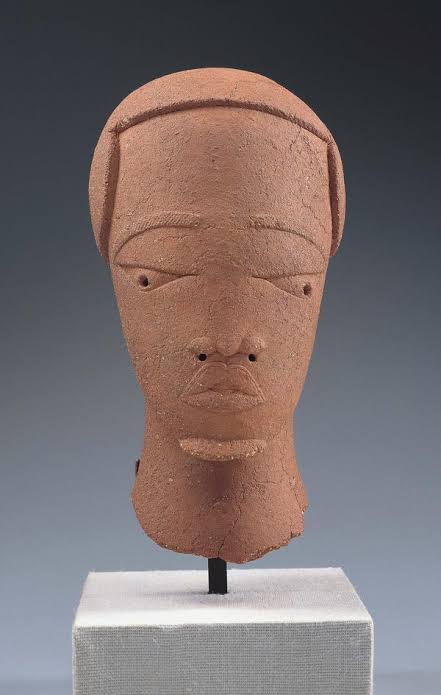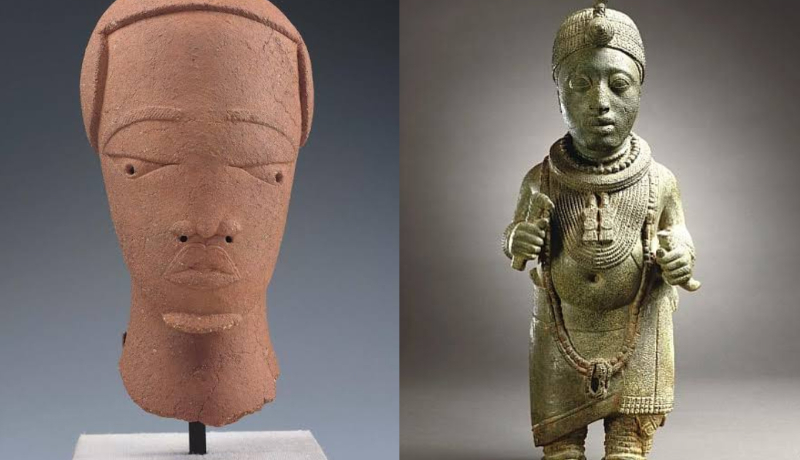Central African art history has received a lot of attention for two reasons: first, the communities that lived there were among the most sedentary tribes in Africa, and second, they produced figurative sculptures that Western collectors could most readily recognize as “art” according to their definition.
Here are some forms of ancient African artwork:
Sculptures

Northern Nigeria
500BC – AD500
The remarkable terracotta pottery heads from the Nok culture of Nigeria, most of which are fragments of figures, are the earliest sculptures that have been discovered. They range in date from 500 BC to 200 AD.
They show that powerful abstract figural representation has been present in Africa for more than 2500 years and are formed of grog and iron-rich clay, although none of them have been discovered in their natural contexts.
They mark the beginning of the African sculptural tradition due to their strong formal features and emotive qualities. They stand out for their sense of caricature and strong sense of fashion, which is seen in their elaborate hairstyles and adornment.
Currently, Nok terracottas hold a significant but solitary place in the history of African art.

elaborate headdress
1000-1300 AD
The fired earthen ware Lydenburg heads, the oldest known African artworks south of the equator, were discovered in the same South African district of the same name. It has been determined that they were buried there in 500 AD. Although little is known about the ancient culture that produced this collection of seven heads, their careful burial demonstrates the importance and regard they had for the people who placed them beneath the earth.
Large rings with furrows surrounding them may denote wealth and power, although it is impossible to know for sure. We can only make educated guesses and put them in the framework of what we know about the history of African art.
Archaeologists have discovered terracotta sculptures that date from 1000 to 1300 AD in the Ife region of Nigeria and the Jenne region of Mali. Throughout Africa throughout the 19th and 20th centuries, impressive terracotta sculptures were still produced.
There are stone sculptures from Sierra Leone’s Sherbro and Kongo tribes that date to no later than the 16th century. Benin also produced highly skilled ivory carvers at the same time.
Metal sculptures and carvings

of Ife 14th-15th Century
The only other material that can endure the termites on the continent is cast metal.
The Igbo-Ukwu tribe of Nigeria has a bronze casting heritage that dates to the ninth century AD. Sites have turned up cast bronze regalia and other pieces of artwork.
The Ife people of Yoruba, Nigeria, who started making extremely good brass and bronze castings in the 12th century and were doing so until the 15th, are credited with carrying on this magnificent heritage to its pinnacle. Amazing realism was attained by life-size heads, masks, and smaller full-length figures, and they all conveyed a calm intensity that was the precursor to that characteristic that we now so highly value in traditional African sculpture. Additionally, they occasionally cast in pure copper, which is technically much more difficult than brass.
From the 15th century till the present, the Yoruba people of Benin carved heads that are now known as Benin bronzes but are actually constructed of brass that was brought over on the trade route in the shape of vessels and ornaments and melted down. Both of these cultures produced works with magical abilities frequently for their Kings, reflecting their beliefs and the chiefdoms and socio-political structures that existed under the rule of a divine King or Ife.

Benin, 16th
Brass plaques with scenes in relief were created by Benin sculptors in response to the Portuguese invasion. The wooden pillars of the royal residence had these plaques affixed to them as adornment.











